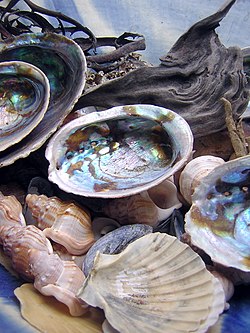Animal shell

A shell is a hard outer layer, which has evolved in a very wide variety of different animals, including molluscs, sea urchins, crustaceans, turtles and tortoises, armadillos, etc.[1]
Seashells
Seashells[2] are perhaps the most familiar and most common shells, both in the wild and for sale as decorative objects. They are usually composed of calcium carbonate, in the form of calcite or aragonite.[3] This can have different forms, one is nacre or mother of pearl. Other kinds of animal shells are made from chitin, bone and cartilage, or silica.
Use of Shells
Shells of many types were popular as human decorations, either used whole or cut into pieces. One used them for all kinds of pendants, beads, buttons, brooches, rings, and hair combs.
Small pieces of colored shell and iridescent shell have been used to create mosaics and inlays which have been used to decorate larger items such as boxes and furniture. Large numbers of whole seashells, arranged to form patterns, have been used to decorate man-made grottos.
Several kinds of sea animals have exoskeletons which one can find after their death in beach drift. Often beachcombers pick them. But usually only those of molluscs (also spelled "mollusks") are known as seashells.
Classes
The majority of shell-forming molluscs belong to two classes: Gastropoda (univalves, or snails) and Bivalvia (bivalves or clams, oysters, scallops, etc.).
Gallery
-
The giant clam (Tridacna gigas) is the largest bivalve
-
Tonicella lineata the "Lined chiton" from the temperate eastern Pacific, a member of the class Polyplacophora
-
The white-lipped snail (Cepaea hortensis) is a land snail
References
- ↑ Scientific names for this type of structure include exoskeleton, test, carapace, and peltidium.
- ↑ more precisely, the external shells of marine molluscs
- ↑ crystallised out in an organic matrix



